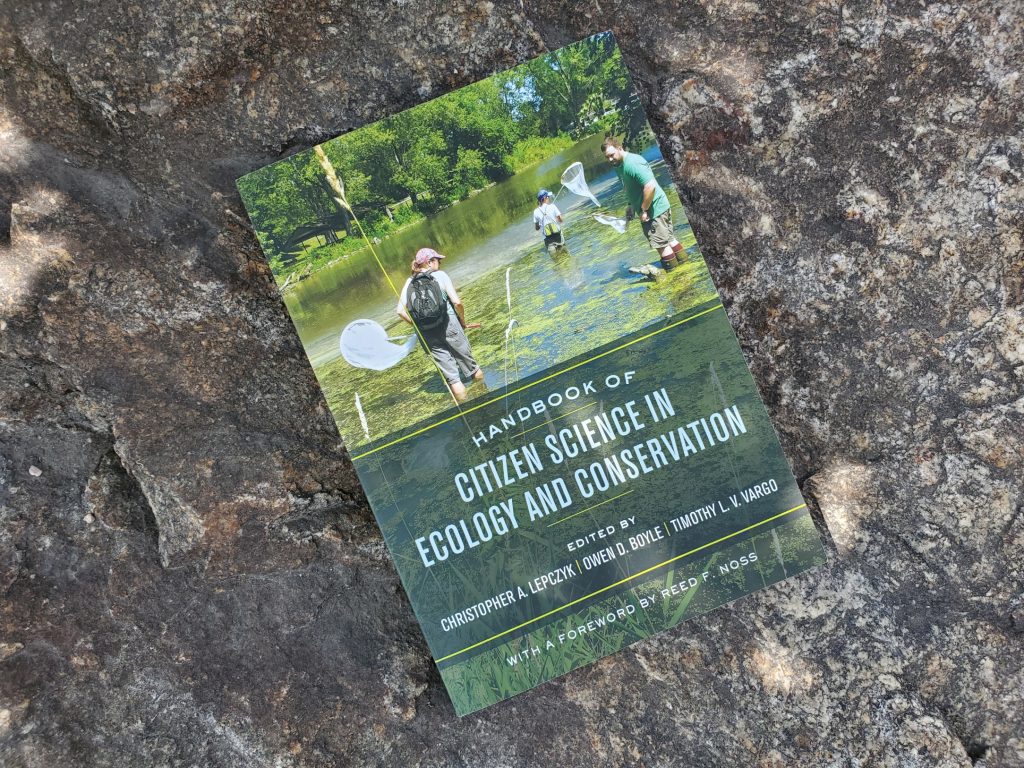
NREL CitSci team publishes in new Handbook of Citizen Science in Ecology and Conservation

Several members of the CitSci team in NREL recently had chapters published in a new book: Handbook of Citizen Science in Ecology and Conservation. Sarah Newman, NREL Research Associate and one of the scientists on the NREL CitSci team, wrote blog about utilizing Citizen Science and this book in research:
Wondering if citizen science is the right approach to answer your conservation questions? Realizing you could use more people-power to study ecology in your area? Feeling a little lost about how or where to get started?
Designing a new citizen science project is not an easy task. It helps to have a team of people to guide your decision making along the way. You may be thinking, “But I don’t have a team!” Or “My team is just me and a coworker and we’re both new to this!” That’s okay. You can still do this. We know, because we’ve been there too. And now, more than ever, you don’t have to forge a trail on your own.
In the new Handbook of Citizen Science in Ecology and Conservation you’ll find guidance from over 50 amazing citizen science professionals about how to navigate your citizen science journey. The book, edited by Chistopher Lepczyk, Owen Boyle, and Timothy Vargo, was the product of a 2008 symposium about citizen science at the Ecological Society of America conference in Milwaukee. It’s designed to walk you through the basics of citizen science and how to design successful projects. You can read it cover to cover or jump around to the chapters that address the challenges you’re tackling.
How the Book is Organized
The book is organized into three main sections: Background [on citizen science], Planning and Implementation of Citizen Science Projects, and Citizen Science in Practice. In the Background chapter, you’ll learn what citizen science is, the history of the field, and current approaches to citizen science. In the Planning and Implementation section you can dive into topics from project planning and design to legal, ethical and policy considerations, to recruitment and retention, collecting and visualizing high-quality data, and evaluating your project.
In the last section, Citizen Science in Practice, you can learn about all of these concepts as applied to six active and successful citizen science projects around the globe from Chicago to the Amazon, from inner-city Milwaukee to the coastal wetlands of Louisiana.
A Valuable Resource for Citizen Science Practitioners
This handbook is not just for people new to citizen science either. It’s also a valuable read for those of us who’ve been around the field for years. For example, the Project Planning and Design chapter includes a section about different models for effective project design that our team uses when working with project managers in early stages of project planning. The Legal, Ethical and Policy Considerations chapter includes a great table with levels of privacy risk for different types of data (and several other useful tables too!). The Training chapter walks through examples from actual citizen science training workshops, discusses in-person and online training, and covers one-time vs on-going training opportunities.
Looking to explore more about data management and visualization? There are two chapters devoted to data specifically, as well as separate chapters covering how to report data back to citizen scientists and how to evaluate your project. In the last section, Citizen Science in Practice, you’ll find more examples of citizen science data and how it’s being used to make important conservation monitoring and management decisions.
Reed F. Noss may state it best in the book’s foreword,
“The need for reliable scientific information and expertise to guide policy, management, and decisions of all kinds related to the environment has arguably never been greater…With a continued lack of significant state and federal funding dedicated to the ecological sciences, as well as a reduced interest in science among some private foundations and non-governmental environmental groups, the prospects seem bleak for generating and communicating the information needed to make intelligent decisions on critical environmental issues. This is where citizen science steps in.”
Whether you’re planning your first or your 10th citizen science project, we encourage you to read through the Handbook for Citizen Science in Conservation and Ecology. You’ll be glad you did.
Looking for more? CitSci can help!
If you’re looking for people to help you plan and implement your citizen science project, we’re here to help. The CitSci team has built, managed and consulted on the creation of hundreds of citizen science projects across the world, including projects with a hyper-local focus and projects with a global reach. Send us a note via our Contact page – we’d be happy to chat with you.
Disclosure: Members of the CitSci team, both former and current, provided authorship on several chapters in the book. The CitSci team does not receive financial compensation for sales of the book.
Current and former NREL personnel with chapters in the book include:
Chapter 9: Collecting High-Quality Data
- Alycia W. Crall (Former NREL grad student)
- Gregory Newman (Current NREL Research Scientist)
Chapter 10: Data Management and Visualization
- Gregory Newman
- Sarah Newman
- Russell Scarpino (Former NREL Research Associate)
- Nicole Kaplan (Former NREL Research Associate)
- Alycia W. Crall
- Stacy Lynn (Current NREL Research Scientist)
This article was contributed by Sarah Newman and originally appeared at https://blog.citsci.org/2020/08/18/handbook-of-citizen-science-in-ecology-and-conservation/ . Learn more about CitSci here.